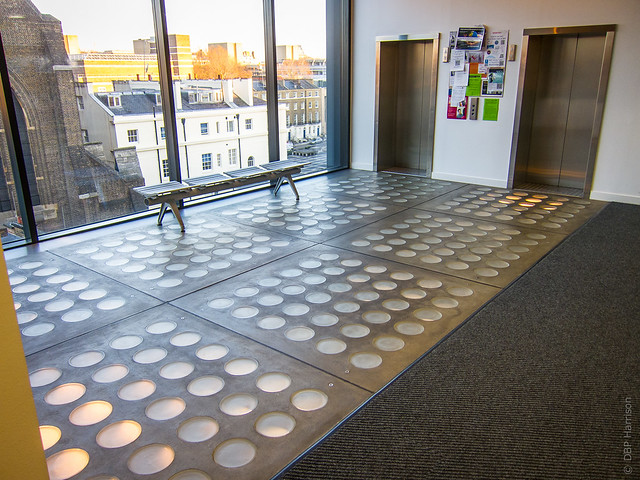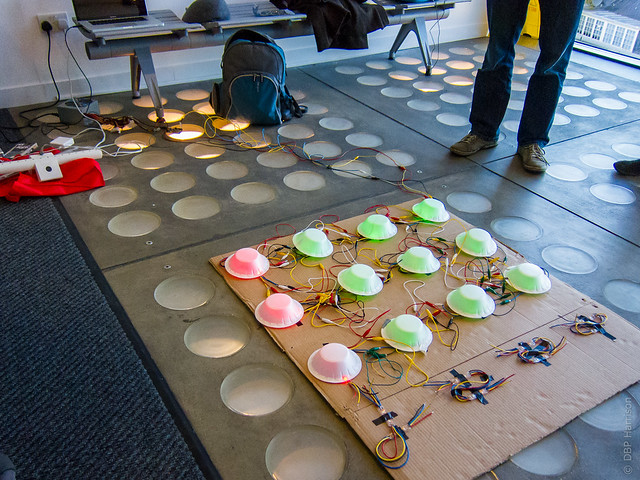I’m going to use this blog to share findings and details about my MSc project, I thought it would be best to start with an introduction to the project and the motivation behind it. I’ve been working on the project for a little while now, so I’ll do the first few updates retrospectively.
It’s a behaviour change project seeking to motivate increased levels of physical activity in the community of a university building. Those who regularly exercise enjoy better health and longer life- just fifteen minutes exercise each day may increase life expectancy by up to 3 years. Yet despite the undeniable benefits of regular exercise, it is suspected that less than 40% of the British adult population meet physical activity guidelines, and that around 60% are overweight or obese.
To motivate increased physical activity we will be creating a large scale interactive surface to be used as a reward for climbing the stairs in the building. The image below shows the surface we’ll be using.
This is the foyer on the sixth floor of the Malet Place Engineering Building (MPEB) in UCL. The building houses a variety of Engineering and Computer Science staff, including the while UCLIC department, where I am an MSc student. It comprises of 288 glass “wells” set in concrete, we’ll be installing LED units (more on these in a further post) into 218 of the glass wells- the 72 wells immediately outside the lifts will not be used, to lower the risk of collisions between lift users and floor display users.
Once installed, users will be able to play Pong by moving across the floor- in order to earn game time users will have to use the building’s stairs, rather than the lifts, recording their usage by swiping their university ID cards at custom built scanners (again, more of these in a further post) located on the landings between the 9 floors of the building.
Once installed, we hope members of the community will appropriate the floor for their own purposes, programming their own games and displays to motivate continued usage of the system.
Floor displays have previously been used for advertising, for wayfinding, as interactive surfaces for play, and for displaying information to motivate behavioural change. Rogers et. al. used a public floor display as a nudge to encourage stair usage in a building in the Open University, The Tidy Street Project, and a recent study in the MPEB have used novel floor displays to visualize information in order to motivate sustainable behaviour. This project will take a different approach, encouraging participants to change their behaviour by offering them a reward for doing so: the interactive surface is used to provide an enjoyable gaming experience, rather than to display information.
Levine coined the term Nonexercise Activity Thermogenesis (NEAT), to refer to all physical activity undertaken which is not eating, sleeping or “sports-like” exercise. This project will take the approach of increasing NEAT activities in people’s daily routines; specifically, taking the stairs rather than the lift.
Previous work studying the use of a floor display in the MPEB has already been completed as part of an undergraduate project earlier this year. The motivation for this project was to decrease energy consumption by displaying information about energy usage and occupancy on 4 different floors in the building. An early prototype of this project is shown below.
I’m intending on keeping this blog updated as the project progresses, as I mentioned a few things have been done already so the next few updates will be catching up. I’ll share any code and schematics as I go, hopefully it will be of some use to somebody!


3 Replies to “Interactive Floor Project Introduction”